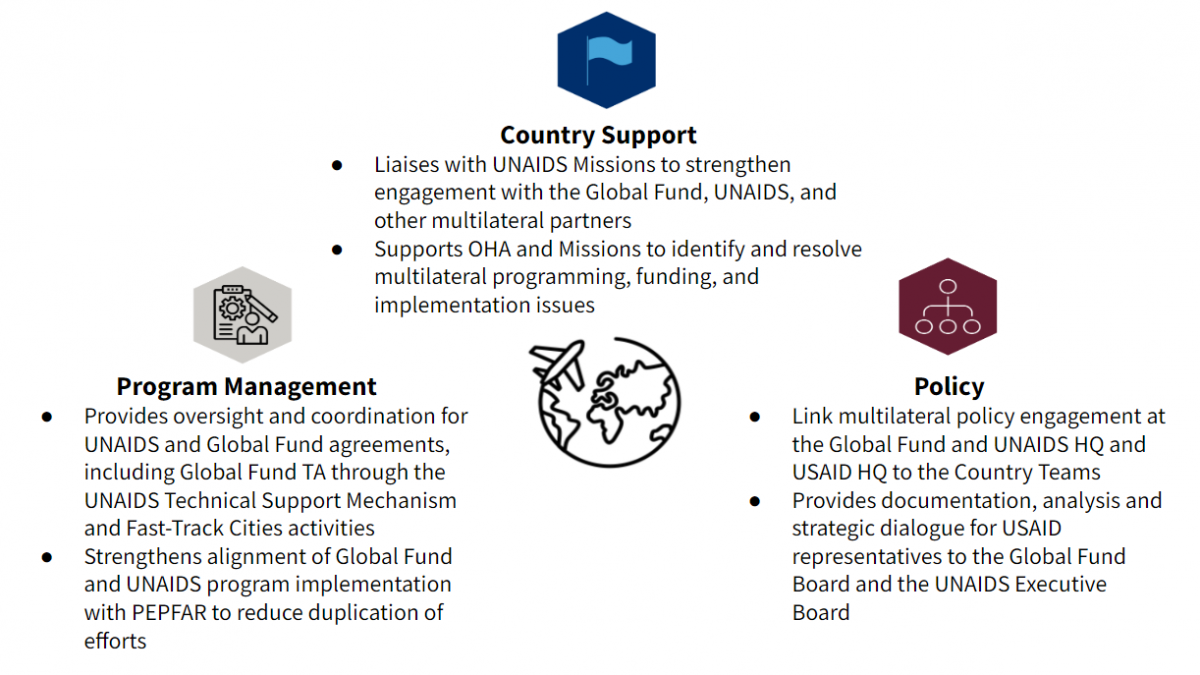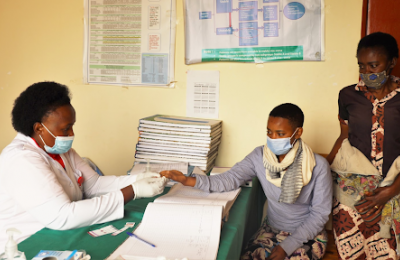Overview
The U.S. Government (USG) invests significant resources into multilateral institutions for policy and programmatic engagement and provision of technical assistance to achieve global health targets. The USAID Office of HIV/AIDS actively engages with the Global Fund to Fight AIDS, Tuberculosis and Malaria (GF), UNAIDS, WHO and many other multilateral partners as well as provides financial management and programmatic oversight of the HIV Global Fund technical assistance (GF TA), manages USAID’s agreements with the Global Fund and UNAIDS, and supports donor coordination.

The three main functions of the USAID Office of HIV/AIDS’ Multilateral Approach: Country Support, Policy Engagement, and Program Management. View the text version of this graphic.
USAID Impact
Country Support
USAID supports the President’s Emergency Plan for AIDS Relief (PEPFAR) programs by facilitating communication and coordination between USAID Missions, the Global Fund, UNAIDS, and other multilateral stakeholders to ensure that unified policy and program approaches are implemented and that joint investments are leveraged to achieve global and national HIV targets.
Policy Engagement
USAID actively participates within the USG interagency processes to design and implement policies that enable PEPFAR, Global Fund, UNAIDS and other multilateral stakeholders to achieve mutual objectives. This includes participating in the USG’s delegations to the Global Fund and UNAIDS Board meetings as well as ensuring that policies are translated into successful implementation.
Program Management
USAID manages the USG’s agreement with the Global Fund and the Agency agreement with UNAIDS. The Global Fund agreement includes the USG’s annual contributions in support of the HIV, TB, malaria, and COVID-19 country grants. The UNAIDS agreement leverages the organization’s expertise to develop global HIV policy, harness data for decision-making, maximize financial resource mobilization, and accelerate effective, efficient implementation to achieve global and national HIV targets.

The Cameroonian network of organizations for people living with HIV (ReCAP+) held meetings to utilize evidence gathered in health facilities, resulting in increased access to services: “Due to our hard work, a ministerial decision in April 2019 abolished out of pocket payments for many HIV services.” Cameroon, July 2022.
Credit: UNAIDS
2022 Achievement Highlights
Country Support
USAID developed country support tools to promote effective engagement between USAID Missions, Global Fund, and UNAIDS country teams for enhanced program alignment. These tools and analyses assisted in increasing coordination with multilateral partners, identifying and resolving implementation bottlenecks, and promoting joint development of PEPFAR country operational plans and Global Fund funding applications for 2023-2025.
Policy Engagement
USAID conducted policy analyses to prepare for the Global Fund and UNAIDS Board/committee meetings. Additionally, in preparation for the 2023-2025 Global Fund Cycle (GC7), USAID supported the Seventh Replenishment Conference hosted by the United States. USAID also advised USAID Missions on Global Fund COVID-19 Response Mechanism policies and programming to best ensure that PEPFAR activities were aligned with Global Fund processes to mitigate the effects of the COVID-19 pandemic on national HIV responses.
Program Management
Through the UNAIDS agreement, USAID provided strategic, targeted assistance for a variety of technical areas, including:
- Increasing strategic information availability, quality, and use to accelerate progress in the HIV response;
- Improving access to and quality of HIV services through civil society networks and faith partnerships;
- Strengthening community-led monitoring;
- Empowering countries to translate policy adoption into HIV program outcomes;
- Reducing stigma and discrimination and gender/human rights related barriers to access; and
- Mitigating the effects of COVID-19 on HIV programs.
An example of this technical support is through the UNAIDS Technical Support Mechanism (TSM) that assisted countries in achieving their Global Fund grant targets. In the 2021-2022 reporting period, TSM undertook 157 technical assistance assignments; activities included:
- Conducting key evidence and strategic information reviews, studies, assessments, and plans in 59 countries to support targeted and efficient high impact HIV responses;
- Implementing the Stigma Index 2.0 in 16 countries;
- Enhancing capacities in 18 countries to improve grant implementation to reach global HIV targets;
- Strengthening HIV cascades for communities of key populations and people living with HIV in 15 countries, including expanding differentiated service delivery;
- Generating strategic epidemiological, programmatic and financial data for evidence-informed decision-making, focusing on key populations in 7 countries in the Asia Pacific region;
- Creating a more coordinated, visible, and vocal civil society role in strategic and programmatic decision-making in West and Central Africa as a result of sustained efforts to strengthen civil society organizations (CSOs) in the region; and
- Scaling joint community-led monitoring in PEPFAR and Global Fund-supported countries.

USAID works with local partners to fight HIV/AIDS. November 2021.
Credit: USAID
Additional Resources
The Global Fund to Fight AIDS, TB, and Malaria
- Global Fund Strategy 2023-2028
- Global Fund Eligibility List: Countries Funded in 2023-2025
- Global Fund 2023 -2025 Allocation and Catalytic Funds
- Global Fund COVID-19 Response Mechanism
- Global Fund Data Explorer
- Global Fund HER Initiative
